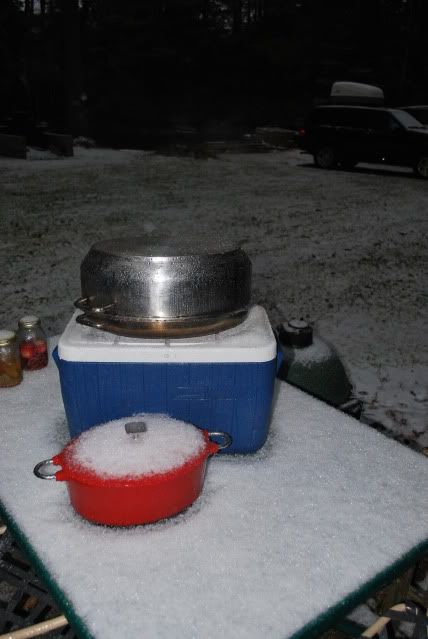Share your photos by tagging us and using the hashtag #BigGreenEgg.
Want to see how the EGG is made? Click to Watch
Cooked Turkey - How to safely cool it down
I posted this in another thread but thought it might be a helpful discussion on it's own - don't want any post Tday illnesses.
In food manufacturing plants the change of temperature after cooking is closely monitored to ensure that food quickly chills through the danger zone. In HACCP plans there is a common cooling chart format used (like this one - http://www.myfloridalicense.com/dbpr/hr/forms/documents/5030_070.pdf
The absolute requirement is "
|
Foods must be cooled from 135°F to 70°F within 2 hours and from 135°F to 41° F or below within 6 hours. |
If product doesn't follow that cooling curve it must be either recooked above 165 or thrown out.
In food plants they have blast chillers (or spiral freezers) - but it is good practice that once food is getting close to 140 (which is much higher than room temperature) - time to get it in the fridge pronto.
Toronto, Canada
Large BGE, Small BGE
Comments
-
this is how we do it

fukahwee maineyou can lead a fish to water but you can not make him drink it -
For me, the problem is that after getting up early, sometimes 4 a.m., and then spending 6 - 8 hours getting everything on the table, after the meal, I'm ready for a long slump in the easy chair. Left overs? what left... ohh!
From what i understand, the thinner the package, the faster the cooling. Don't put anything in in pans thicker than 2". I cut quickly, and package the pieces in freezer bags and then squash pretty thin.
Freezers don't really freeze stuff too well. The warm food may defrost what is already there, and air just doesn't chill well. The best solution is to make an ice bath, and dunk the packages in that before placing in the freezer or fridge.
But, as I said, I'm usually too tired by that point to make up an ice bath. Dropping the bagged meat into a sink full of cold water works pretty well to bring the temperature under 65F. Also, I have an enclosed porch, and where I live, the concrete slab is now at 45F. An hour or so on that brings a sealed pan or package down really well.
Categories
- All Categories
- 182.7K EggHead Forum
- 15.7K Forum List
- 459 EGGtoberfest
- 1.9K Forum Feedback
- 10.3K Off Topic
- 2.2K EGG Table Forum
- 1 Rules & Disclaimer
- 9K Cookbook
- 12 Valentines Day
- 91 Holiday Recipes
- 223 Appetizers
- 516 Baking
- 2.4K Beef
- 88 Desserts
- 163 Lamb
- 2.4K Pork
- 1.5K Poultry
- 30 Salads and Dressings
- 320 Sauces, Rubs, Marinades
- 543 Seafood
- 175 Sides
- 121 Soups, Stews, Chilis
- 35 Vegetarian
- 100 Vegetables
- 312 Health
- 292 Weight Loss Forum

